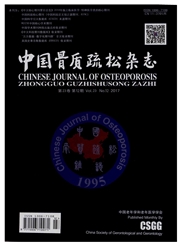

 中文摘要:
中文摘要:
目的探讨50-60岁绝经后骨折女性25羟维生素D3和骨密度、骨代谢指标的关系。方法选择2014年7月至2015年9月因骨折在我院骨科行手术治疗的50-60岁绝经后女性90例,检测患者腰椎和股骨近端部位骨密度并分为骨质疏松组、骨量减少组及骨量正常组。检测患者身高、体重及25羟维生素D3、骨碱性磷酸酶、骨钙素、I型胶原羧基末端肽、I型原胶原羧基末端肽及尿Ⅰ型胶原氨基末端肽等骨代谢指标。结果血清25羟维生素D3水平随着骨密度降低而降低(P〈0.05);血清骨碱性磷酸酶、骨钙素、I型胶原羧基末端肽、I型原胶原羧基末端肽及尿I型胶原氨基末端肽水平随着血清25羟维生素D3水平降低而升高(P〈0.05);血清25羟维生素D3水平随着年龄增加而降低(P〈0.05)。结论在50-60岁绝经后女性骨折患者中,血清25羟维生素D3水平与骨密度存在正性相关关系;血清25羟维生素D3与血清骨碱性磷酸酶、骨钙素、I型胶原羧基末端肽、I型原胶原羧基末端肽及尿I型胶原氨基末端肽水平存在负性相关关系。50-60岁绝经后女性应及时补充维生素D,并随着绝经年限的增加而适当增加,可以增加骨量,从而可能减少各种并发症的发生。
 英文摘要:
英文摘要:
Objective To investigate the change in 25-hydroxyvitamin D3 levels and its relationship with BMD and bone turnover markers in postmenopausal women aged 50-60 years with fractures.Methods A total of 90 cases of postmenopausal women aged50-60 years treated for fracture in our hospital from July 2014 to September 2015 were selected.BMD was measured at lumbar spine and proximal femur by dual energy X-ray absorptiometry produced by GE medical system in USA.The cases were divided into three groups according to BMD:osteoporosis group,osteopenia group and normal group.In all the patients measurements undertaken included height,weight and bone metabolism markers,including 25-hydroxyvitamin D3,bone isoenzyme of alkaline phosphatase(BALP),Osteocalcin(OC),C-terminal crosslinking telopeptides of type I collagen(s-CTX),Type I procollagen carboxyterminal peptide(PICP),and N-terminal crosslinking telopeptides of type I collagen(u-NTX).Results Serum level of 25-hydroxyvitamin D3 decreased with the decrease of BMD(P 〈 0.05).Serum level of 25-hydroxyvitamin D3 decreased with the increase of BALP,0C,s-CTX,PICP and u-NTX(P 〈0.05).Serum level of 25-hydroxyvitamin D3 decreased with the increase of age(P 〈0.05).Conclusion There was a significant positive correlation between 25-hydroxyvitamin D3 and BMD.Meanwhile there was a significant negative correlation between 25-hydroxyvitamin D3 and bone turnover markers(ie.BALP,OC,s-CTX,PICP and u-NTX).Vitamin D3 supplement should be promptly given to postmenopausal women between 50 and 60 years of age in order to increase bone mass and prevent the incidence of complications.
 同期刊论文项目
同期刊论文项目
 同项目期刊论文
同项目期刊论文
 HIF-1α disturbs osteoblasts and osteoclasts coupling in bone remodeling byup-regulating OPG expressi
HIF-1α disturbs osteoblasts and osteoclasts coupling in bone remodeling byup-regulating OPG expressi Dynamic hip screw, proximal femoralnail antirotation and InterTan nail for intertrochanteric fractur
Dynamic hip screw, proximal femoralnail antirotation and InterTan nail for intertrochanteric fractur 期刊信息
期刊信息
